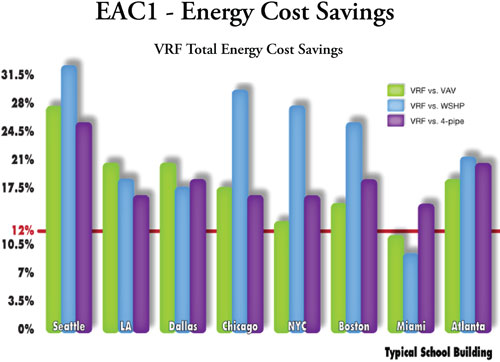Cool VRF Technology
VRF Sustainability and LEED®
VRF system can contribute a great deal to meeting LEED requirements in the Energy & Atmosphere (EA) category (21 points) and Indoor Environmental Quality (IEQ) category (3 points.)
EA Credit 1: Optimize Energy Performance
1–19 PointsIntent
To achieve increasing levels of energy performance beyond the prerequisite standard to reduce environmental and economic impacts associated with excessive energy use.OPTION 1. Whole Building Energy Simulation. Demonstrate a percentage improvement in the proposed building performance rating compared with the baseline building performance rating.
The required verification can be accomplished by using modeling software that incorporates VRF systems. Through a partnership with EnergySoft, selected VRF manufacturers helped integrate VRF functions into an existing software tool called EnergyProTM, which can be used to model VRF systems. EnergyPro energy modeling results are acceptable for use in LEED documentation (EA Credit 1.) EnergyPro is available to designers and engineers at a discounted price through many VRF manufacturers. To date, EnergyPro is the only software with the capability to model VRF systems. It uses DOE2.1e (building energy use and cost analysis software developed mostly under funding from the U.S. Department of Energy) to model and compare VRF to other HVAC systems. (See chart of an example of EnergyPro modeling of VRF cost savings in a single-story school where both the EA prerequisite and the minimum percentage of savings to achieve points were met.)
EA Credit 5: Measurement and Verification
3 PointsIntent
To provide for the ongoing accountability of building energy consumption over time.OPTION 1. Develop and implement a measurement and verification (M&V) plan
Measurement and verification can be met by the use of integrated maintenance software offered by VRF manufacturers. In addition to monitoring and collecting VRF system data, the software saves data for the purposes of trending and system analysis.
IEQ Credit 1: Outdoor Air Delivery Monitoring
1 PointIntent
To provide capacity for ventilation system monitoring to help promote occupant comfort and well-being.
To obtain this credit, an energy recovery ventilator (ERV) can be utilized with CO2 sensors and integrated into the VRF controls network. When an ERV system is included, some VRF systems can earn points toward outdoor air delivery monitoring, increased ventilation and indoor air quality management during construction, before occupancy. VRF indoor units can be designed to avoid cross-contaminating zone air, adding to indoor chemical and pollutant source control.
IE Q Credit 6.2: Controllability of Systems–Thermal Comfort
1 PointIntent
To provide a high level of thermal comfort system control by individual occupants or groups in multi-occupant spaces (e.g., classrooms or conference areas) and promote their productivity, comfort and well-being.
The zoning ability with VRF systems allows occupant control via wall-mounted remote controllers. Occupants can control airflow direction, speed and temperature.
IE Q Credit 7.1: Thermal Comfort–Design
1 PointIntent
To provide a comfortable thermal environment that promotes occupant productivity and well-being.Requirements
Design heating, ventilating and air conditioning (HVAC) systems and the building envelope to meet the requirements of ASHRAE Standard 55-2004, Thermal Comfort Conditions for Human Occupancy.
Again, VRF systems with its integrated controls, comparative modeling software and integrated maintenance software can provide and document appropriate thermal comfort.
Maintenance
In contrast to many other systems which require retro-commissioning and constant maintenance to preserve their installed efficiency, VRF technology has all the logic built in and is continuously modified during daily operations as it maximizes performance and comfort. Normal maintenance consists of changing or cleaning filters and cleaning coils. System tests are available to check wiring, sensor and the refrigerant levels. Many systems allow an indoor unit to be serviced while other indoor units within the same piping system are still in operation. VRF technology also allows for lower maintenance costs than water-cooled chillers since water treatment issues are avoided.
 |
EnergyPro comparison of VRF cost savings in a single-story school. The building was set up to be code compliant; the only factor changed was the HVAC system. The VRF system was compared to a 4-pipe fan coil unit system, a water source heat pump system (WSHP), and a packaged variable air volume system (VAV) with hot water reheat. In many cases a VRF system met or exceeded the 10 percent improvement required by EA Prerequisite 2 and also met or exceeded the 12 percent required to achieve points under EAC1. Image courtesy of Mitsubishi Electric |
Summary of Features of VRF Inverter Compressor Technology - More energy efficient compared with other HVAC systems - Sizing flexibility with variable capacity - Offers design, location and installation flexibility - Space-saving compact units - Reduced piping and ductwork - Quiet operation - Zoning capabilities- Lower total installed costs compared with other HVAC systems - Lower life cycle costs - Costs of installing an extensive system can be recovered within five years - Enables long runtimes without continually re-cycling - Built-in logic allows continuous monitoring and controlling - Accelerated cooling and heating performance means that the temperature setpoint is reached faster than with traditional HVAC systems - Integrated controls allow monitoring and control from remote location - Low rotation speed at start-up keeps power current minimal, thus eliminating power spikes that can affect appliances - No ON/OFF as in conventional systems |
Conclusion
With their design and installation flexibility, energy saving features and delivery of comfort to occupants, VRF systems are a viable alternative to traditional HVAC systems. Since 22 percent of the country's energy is consumed by HVAC in commercial buildings, a system that reduces energy usage should go a long way towards increasing sustainability–and earning LEED credits. VRF technology offers an environmental and cost effective option for design professionals in the United States.
 |
Ductless & VRF solutions from Mitsubishi Electric Cooling & Heating, America's #1 selling brand of ductless, are compact and quiet. And with no ductwork, they minimize impact on your design while providing extremely energy efficient solutions. http://www.mitsubishipro.com/en/professional |








